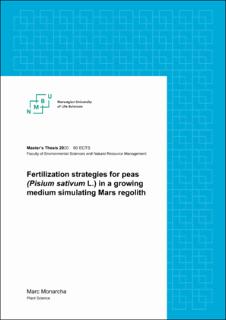| dc.description.abstract | In 2011, Andy Weir published the thought-provoking novel “The Martian”, in which a fictional astronaut, Mark Whatney gets left behind on Mars where in order to survive, he must find a way to grow food. As of March 2020, the book is considered a science fiction. History shows that time and time again, ideas such as the moon landing were largely considered intangible, until certain people put in the joint effort and made them real. Now, with the hope of going to Mars permanently appearing more and more likely, it is worthwhile to test ways of growing food there. In this experiment, the Mojave Mars simulant (MMS) has been used as a Martian regolith analog to simulate Martian conditions. The analog shares similar chemical and physical features with sampled material from Mars. This study is aimed at investigating how well peas (Pisium sativum) grow in MMS compared to a nutrient poor sandy soil; which kind of fertilizer (inorganic, organic, biofertilizer) gives the best plant development and yield; whether repeated additions of organic matter improve growing conditions; and finally whether plants grown in MMS will have a lack of potassium (since a lack of potassium has been speculated in a different experiment). Two pot experiments were conducted under controlled conditions. In the first, peas were sown in the MMS and in a nutrient poor sand with the following fertilizer treatments: without nutrients (control), synthetic fertilizer, rhizobium without potassium, rhizobium with potassium, and digested sewage sludge. In the second experiment, the MMS pots with soil from the first experiment were used again with an addition of the same amount of sewage sludge each. Again, peas were used as a test crop. Results showed that plants in the MMS grew poorly compared to those in the nutrient poor sand. Plants grown in the MMS had symptoms of boron toxicity. Addition of sewage sludge lowered the pH of the alkaline MMS and reduced boron availability, increasing its biomass and yield. Finally, plants showed no sign of potassium deficiency in the MMS treatments, even when no additional potassium was supplied. The results of this experiment are not conclusive as to whether peas can grow on Mars. To answer this question, there is still much more research and experimentation to be done. | en_US |

